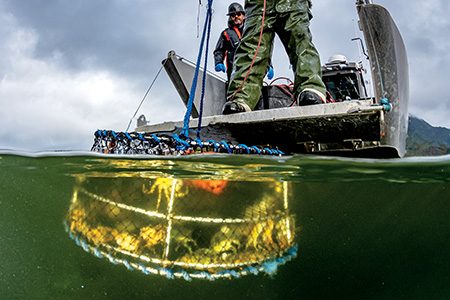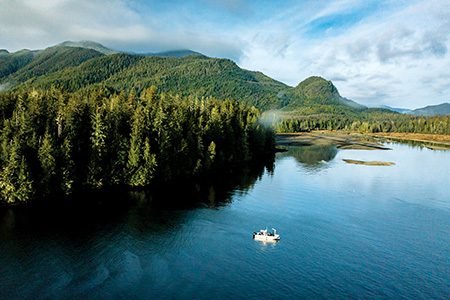At the end of a slippery dock in Tofino on Vancouver Island on a wet, chilly day in February, a crew from the Coastal Restoration Society (CRS), a nonprofit dedicated to restoring and maintaining coastal health in British Columbia, Canada, is preparing for a fight.
They plow through the driving wind, waves, and rain to arrive in a shallow bay in Clayoquot Sound in the traditional territory of the Ahousaht First Nation, who are working with the CRS to manage the situation. Fed by a salmon spawning river, the bay is the perfect habitat for the invaders known as European green crabs.
One of the world’s most destructive invasive species is gaining new ground — or water — in Canada and up to Alaska. Carcinus maenas, which translates to “raving mad crab,” outcompetes many local crab species in devouring clams, oysters, and mussels, and they sometimes even eat other crabs and juvenile fish. They destroy seagrass, an essential habitat for juvenile salmon, herring, rockfish, and many other marine animals. Seagrass is also an important carbon sink, up to 35 times more efficient at storing carbon than rainforests. The invaders can uproot entire meadows.


On Clayoquot Sound, the team starts pulling up traps. CRS technician James George explained that they rotate their trapping among four different spots, staying in each spot for a week to clear out as many crabs as they can. “We will slay today because we haven’t trapped here in a month,” he said. He was right.
European green crabs first arrived in North America in the 1800s, likely in the ballast water of ships from Europe and North Africa. In the 1980s they hitched a ride on vessels traveling through the Panama Canal and entered California’s waters, eventually reaching British Columbia in 1989. Almost everywhere humanity’s ships have gone, so too have the crabs. They are now established in Australia, South Africa, South America, and on both coasts of North America.
The crabs are resilient and can tolerate a wide range of temperatures and salinities, but the young ones have a tougher time surviving in the cold temperatures of northern British Columbia and Alaska. As climate change warms those waters, however, it’s easier for the pests to spread northward.
A big reason why they spread so quickly is that females can produce 185,000 eggs at a time. The crabs begin life as tiny larvae, drifting in ocean currents, expanding their territory little by little to wherever is suitable, such as the seemingly endless shallow inlets and estuaries of Vancouver Island. But they aren’t everywhere — yet. The Salish Sea between Vancouver Island and the mainland is currently free of green crabs. But given how remote and complex these ecosystems are, more outbreaks are highly likely.


They can be kept at bay if we catch their arrival early enough. “You can really see the difference,” George said. “We will catch fewer crabs by the end of the week, and the eelgrass has started to come back in places we trap.”
It seems counterintuitive, but trying to completely wipe them out from an established area can make the situation worse. Researchers from the University of California, Davis, and others ran an experiment from 2009 to 2014 in the Seadrift Lagoon in Stinson Beach, California, where they trapped so heavily that the number of adult green crabs dropped by 90 percent. But then later the population exploded. Green crabs are cannibals, and the adults keep the population in check by eating some of the young ones. Traps catch only the adults, so a bunch of juveniles were ready to grow big and strong. If we can’t eradicate them, we will have to manage them to avoid the worst consequences. That means trapping a lot of crabs, but not all of them.
The question of what to do with the crabs once they are caught is a prickly one. They are low-yield but edible, although Health Canada hasn’t approved them for human consumption. Some companies in the U.S. have taken a stance of if you can’t beat ’em, then eat ’em, trying to drum up demand among restaurants and consumers. Critics of this plan fear that creating a profitable market for the hand-sized crabs will lead to intentional and unintentional spread.


For the moment, the CRS flash freezes them in a massive industrial freezer. The crabs are subsequently turned into fertilizer that can be used by the Ahousaht at their behest or sent to landfills.
When I ask our captain, Alex King, a scientist and the CRS regional project manager, if she has heard of the New Hampshire whiskey being made from the crabs, she laughs. “Yeah, everyone I know has asked me about that,” she said. “It’s great for raising awareness about the issue, and I think there is a lot of potential for more of that sort of thing, but it’s so small scale. We need to think much bigger.”
The CRS has become efficiently expert at catching the European green crabs with virtually no bycatch of unwanted species, but they are not equipped to turn the crabs into fertilizer, feed, bait, whiskey, bioplastic bags, or any of the other suggested uses for the hundreds of thousands of green crabs they catch. But an opportunity is there for someone who can.
For now we are stuck having to manage these crabs long term. “At least it’s permanent jobs,” CRS technician Joe Elley shouted over the roar of the engines as we glide back to Tofino. He is not wrong.



© Alert Diver — Q1 2024